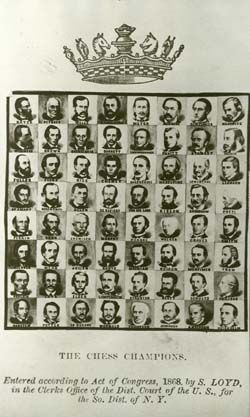
When contacting us by e-mail, correspondents are asked to include their name and full postal address and, when providing information, to quote exact book and magazine sources. The word ‘chess’ needs to appear in the subject-line or in the message itself.
| First column | << previous | Archives [6] | next >> | Current column |
The game we had in mind was 1 e4 e6 2 d4 Qf6 3 e5 Qf5 4 Bd3, which was given on page 9 of The Pleasures of Chess by Assiac (New York, 1952). It may, however, be argued whether, on f5, the queen is in the ‘middle of the board’. If only d4, d5, e4 and e5 are admitted, no four-move solution has been found, although there are various ways in five moves, such as 1 e4 e6 2 d4 d5 3 Qh5 Nf6 4 Qg5 h6 5 Qe5 Bd6 and 1 e4 c5 2 Qh5 d6 3 Qd5 e5 4 Bd3 Nc6 5 Nc3 Be6. Indeed, Black can even include a ‘null’ move, examples being 1 e4 a6 2 Qh5 Ra7 (or other) 3 Qe5 e6 4 f4 f5 5 c3 Nc6 and 1 e4 e6 2 d4 Ke7 (or other) 3 Qh5 d5 4 Qe5 f5 5 f4 Nc6. Not surprisingly, therefore, a solution has been found which takes half a move less: 1 Na3 e5 2 Nc4 Qh4 3 d3 Qd4 4 f4 d5 5 Be3. Our thanks to a number of correspondents who have contributed to this topic, and particularly Yasser Seirawan (Amsterdam) and Richard Forster (Zurich).
In C.N. 3467 Owen Hindle suggested that the photograph of James Leonard reproduced in C.N. 3451 might be from Samuel Loyd’s ‘photographic chessboard’, and we asked for further details about that Loyd item. It has now been found by John Hilbert (Amherst, NY, USA), who has kindly forwarded a copy:

For a larger version, click here.
Information is still being sought about the ‘Philidor chess men’ illustration in C.N. 3446. Our only progress so far is to note that it was included between pages 160 and 161 of the Chess Player’s Chronicle, 1850.
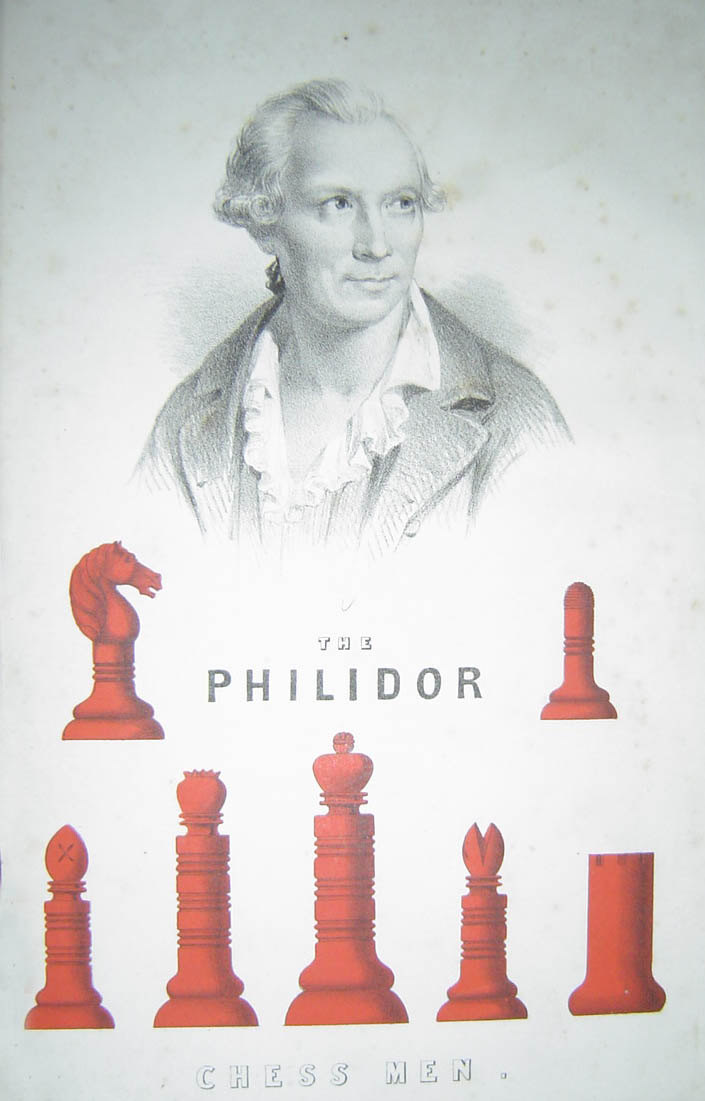
The illustration was page 359 of Vorlesungen über die wissenschaftlichen Grundlagen der Elektrotechnik by Milan Vidmar (Berlin, 1928).
Our collection contains various non-chess works by Vidmar, but the only one in which we have found any chess references is Das Ende des Goldzeitalters (second edition, Brunswick, 1942).
On 7 February 2005 the UK television programme Mind Games (BBC Four) had William Hartston as a guest contestant. He was in fine form in the face of a thorny set of braintwisters. For instance, cuboid is a three-dimensional shape with six faces but also a word with six letters, and the teams were required to name another three-dimensional shape with the same number of faces as letters. It was Hartston who supplied the answer: dodecahedron (12 faces, 12 letters).
When he last did chess on television we do not know, but he is certainly the best presenter of the game we have seen.
Let it be imagined for a moment that C.N. 3589, the ‘Queen trapped’ item, had been altogether different. Supposing that it asserted that the shortest game given there, 1 e4 e6 2 d4 Qf6 3 e5 Qf5 4 Bd3, had occurred in a simultaneous exhibition, with Capablanca as Black, and that, upon resigning at move four, the Cuban had furiously overturned the board, injuring two spectators (one of them seriously) and screaming, ‘Chess is not a game, science or sport, but a loathsome waste of time’. End of item. Incredulous readers would obviously then have asked us to specify our grounds for disseminating such a story and would, no doubt, have expressed shock that, in any case, we had not given chapter and verse unprompted. Where did we believe the display had taken place? From which publication had the game-score been taken? How did we know what Capablanca had shouted? But let it be further assumed that we steadfastly ignored all such enquiries and demands, simply deciding that we had written enough and leaving it to other authors or researchers to pursue the matter if they so wished.
The practical outcome of such an episode would be self-evident: whatever reputation this column may have built up over the years for concern about truth, accuracy and decency would, overnight, be in tatters. Yet although the above Capablanca yarn is, intentionally, an extreme invention, its essence corresponds exactly to what is seen day after day regarding chess history and chess masters: unconfirmed game-scores, uncorroborated facts, unproven anecdotes and unsubstantiated quotations. The only difference is that, unless the circumstances are spectacularly outlandish, few eyebrows are raised.
In C.N. 3160 we commented: ‘Proper sources are not optional extras or lace frills; they are required as an integral part of chess writing.’ The remark came back to mind a few days ago when John Donaldson (Berkeley, CA, USA) kindly sent us the following photograph of Capablanca and A.J. Fink:
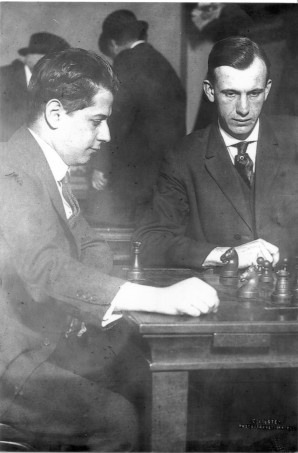
Mr Donaldson also referred us to a simultaneous game between the two, included in his article at the following webpage: http://chessdryad.com/articles/mi/donaldson.htm
The game, a draw in San Francisco on 11 April 1916, intrigued us,
because after its appearance on page 212 of The Games of José
Raúl Capablanca by R. Caparrós (Yorklyn, 1991) we marked our
copy with a note that at move 35 Capablanca had a forced win (a
forced mate, in fact) by capturing on f7. At the time we wished to
verify the accuracy of the game-score but were unable to ascertain
Caparros’ source. He specified (see pages 154 and 277) that it was
one of many games gleaned from ‘local papers and chess magazines’.
That was all: ‘local papers and chess magazines’. No titles or
dates, let alone page numbers. Other categories of sources vaguely
lumped together by Caparrós were ‘Cuban papers’, ‘Cleveland
papers’, ‘private research’ and ‘untraceable source’.
John Donaldson has been searching various likely sources for the game, without success so far, which means that it is still not known whether Capablanca really missed such an obvious win at move 35. The score as presented by Caparrós runs: 1 d4 d5 2 Nf3 Nc6 3 c4 e6 4 Nc3 Be7 5 Bf4 Nf6 6 e3 a6 7 Rc1 O-O 8 Bd3 dxc4 9 Bxc4 Na5 10 Bd3 c5 11 dxc5 Bxc5 12 O-O Nc6 13 Ne4 Be7 14 Qc2 Nb4 15 Nxf6+ gxf6 16 Bxh7+ Kg7 17 Qb1 f5 18 Rfd1 Qe8 19 Bxf5 exf5 20 Nd4 Nd5 21 Nxf5+ Bxf5 22 Qxf5 Nxf4 23 Qxf4 Rh8 24 Rc7 Rd8 25 Rxd8 Qxd8 26 Qg4+ Bg5 27 Rxb7 Rh4 28 Qf3 Be7 29 b3 Rh6 30 g3 Qd6 31 h4 Rf6 32 Qg4+ Rg6 33 Qf5 Qd1+ 34 Kg2 Bxh4 35 Qf3 Qxf3+ 36 Kxf3 Bf6 37 Rb6 Bc3 38 Rxg6+ Kxg6 39 Kg4 Kf6 40 f4 Ke6 41 e4 f6 42 Kf3 a5 43 Ke3 Be1 44 g4 Kd6 45 g5 fxg5 46 fxg5 Ke5 47 g6 Drawn. It will be noted that Mr Donaldson’s article gave White’s 33rd move as Qf4, not Qf5. In either case this would mean that Capablanca overlooked a forced mate, but a suggestion now from Richard Forster (Zurich), supported by Mr Donaldson, is that it is far more likely that Capablanca played a third move, 33 Qe4, after which the rest of the game makes sense and no mating line was missed. Whether any error in the moves was a mistranscription by Caparrós has yet to be discovered.
Adolf Jay Fink (1890-1956) was best known as a problemist, and it may be wondered whether, in the photograph above, Capablanca was studying one of his compositions. Page 53 of Chess Pie (1922) stated, ‘Fink is a strong chessplayer and has drawn twice with Capablanca in simultaneous exhibitions’, but it seems that the other game has not been traced.
Caparrós’ book on Capablanca can be relied upon for nothing, and
below is another score from the same page as the Fink game: 1 f4
d5 2 e3 e6 3 Nf3 Nf6 4 b3 c5 5 Bb2 Nc6 6 Bb5 Nd7 7 O-O f6 8 d3 Qc7
9 Nbd2 a6 10 Bxc6 bxc6 11 Nh4 g6 12 e4 Rg8 13 f5 e5 14 fxg6 hxg6
15 Nxg6 Rxg6 16 Qh5 Kf7 17 Nf3 Kg7 18 Nh4 Rg5 19 Nf5+ Kg8 20 Qe8
Bb7 21 Qe6+ Kh8 22 Rf3 Rh5 23 Rg3 Rh6 24 Qf7 Resigns. This,
Caparrós stated, occurred between Capablanca and A.M. Isaacson, in
New York, 1915, and it has been unquestioningly copied by various
databases, but if the score is correct Capablanca missed 24 Qg8
mate. Did he really? It seems obvious that Black played 23...Bh6
rather than 23...Rh6 but, again, Caparrós gave no proper source
for the game, merely indicating (see pages 154 and 278)
‘Pittsburgh papers’. A ‘revised 2nd edition’, published by Chess
Digest, Texas in 1994, was also dire.
Scarcely better is a would-be reference book, Chess Results, 1747-1900 by G. Di Felice (Jefferson, 2004). Much can easily be written about its factual errors, but a more serious general defect is that the reader is offered no clue as to where a given crosstable or match chart came from. Incredibly, the ‘Sources’ amount to a single page (page 209), i.e. a bare list of books and other publications, such as ‘Chess’ and ‘Quebec Morning Chronicle’. No particulars are provided, and no link is made between such publications and any individual table in the book. In short, the ‘Sources’ page is worthless and so, in consequence, is much of the book for anyone wishing to check the information it provides.
Many books deign to give no sources at all – even of the nebulous, dateless ‘Chess’ or ‘private research’ variety – and show disrespect for masters by serving up dubious anecdotes and quotes. An especially awful example, discussed in C.N. 3112, is 2010 Chess Oddities by A. Dunne (Davenport, 2003), and now we see that the same author intends to bring out a volume entitled Great Chess Books of the Twentieth Century in English. What next? A twenty-first century edition of H.J.R. Murray’s A History of Chess, revised and updated by Eric Schiller?
In case anyone considers that a call for sources in chess books is somehow donnish, pedantic or otherwise excessive, we propose another comparison of the kind offered in C.N. 2708 (see page 334 of A Chess Omnibus). In 2004 the British comedian and actor Frankie Howerd (1917-92) was the subject of a popular biography by Graham McCann, published in hardback by Fourth Estate, London at £18.99. It comprises 369 pages, with 41 photographs, but the narrative itself ends at page 289. Then come: a) a detailed 39-page ‘List of Performances’ (stage, radio, television, cinema, recordings) with precise dates and cast-lists, b) a 27-page ‘Notes’ section (giving exact citations for quotations and other references in the body of the book), c) a three-page bibliography and d) a nine-page general index. In short, the reader is treated with respect and informed of the exact provenance of the information presented about Howerd’s life and career. In many fields such ‘academic’ standards are commonplace, but in chess they are rare and have to be fought for, every inch of the way.
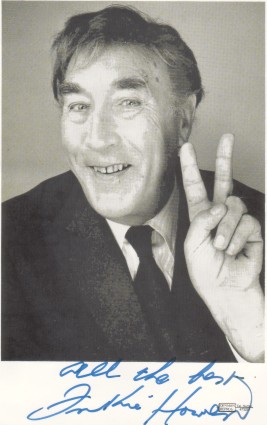
Such is Jeremy Gaige’s standing among chess cognoscenti that a lesser light may be eager somehow to out-Gaige him. G. Di Felice’s Preface to Chess Results, 1747-1900 states that the book contains more crosstables than Gaige’s Chess Tournament Crosstables, Volume 1 (Philadelphia, 1969) and so it does, but, of course, after 1969 Gaige continued to add to his archives, and at a remarkable rate. In 1984 he brought out a book of which Di Felice shows no awareness, Chess Tournaments A Checklist Vol. I 1851-1950. Tournaments for which Gaige then possessed the crosstable were marked in the checklist with an asterisk, and their number far exceeds those included in Di Felice’s book some two decades later. A sequel by Gaige, also published in 1984, dealt with tournaments from 1951 to 1980.


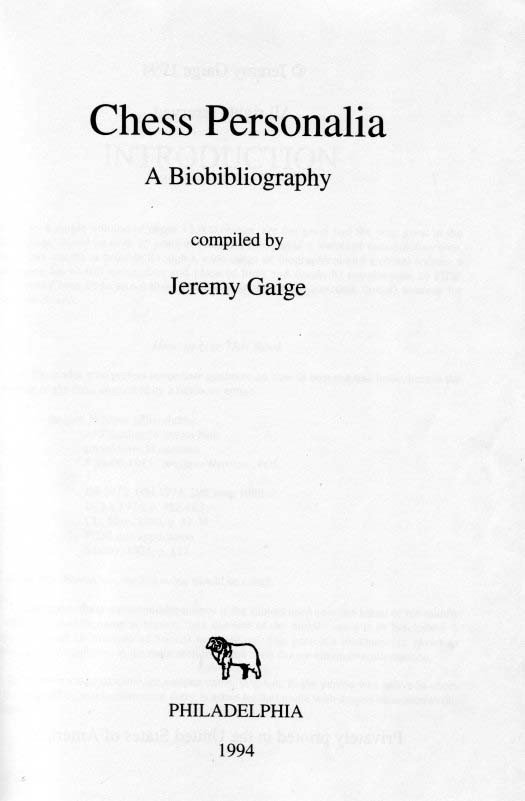
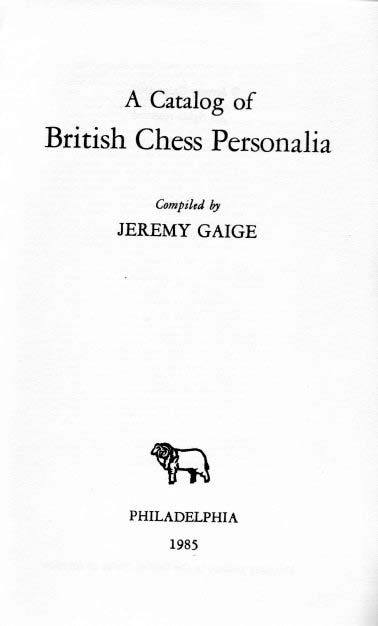

It is on his crosstables project (four volumes) and Chess Personalia A Biobibliography (Jefferson, 1987) that his reputation is founded and will endure, but there has been much else. Our collection contains, for instance, a 1985 revised edition of the first Checklist book, as well as seven bound versions of his Index of Obituaries in the British Chess Magazine, a 1994 edition of Chess Personalia and such volumes as FIDE-Titled Correspondence Players (1985), A Catalog of British Chess Personalia (1985), Catalog of USA Chess Composers (1987), Swiss Chess Personalia (1987), FIDE Female Titleholders (1991) and USA FIDE-Titled Players & Arbiters (1993).
On pages 58-60 of the 8/1987 New in Chess we wrote an appreciation of Jeremy Gaige’s unique contribution to chess scholarship. John Hilbert (Amherst, NY, USA) informs us that in 2004 he unavailingly nominated Gaige (and Walter Penn Shipley) for the USCF’s Hall of Fame. Our own view is that halls of fame and other soi disant achievement awards are embarrassingly nugatory (would Gaige really have his status enhanced as an ‘inductee’, alongside writers like Fred Reinfeld and Al Horowitz?), but if such conferrals must exist there is no US chess figure more deserving than Gaige. In any case, we agree with every word written by Dr Hilbert in his nomination submission, which is reproduced below with his permission:
‘As anyone who has tried to do serious work in chess history knows, such work would, in large measure, not be possible without Gaige’s extensive contributions. His four volume Chess Tournament Crosstables remains the standard for the period 1851-1930. Even more importantly, his monumental Chess Personalia, with over 14,000 bibliographical entries listing essentially every major chess player for the past 200 years or more, is the bible for anyone wishing to work on the history of the game. I’ve published eight books on chess history, biography, and tournament play in the past eight years, and in all honesty can say I would not have attempted to write any of them were it not for the extraordinary work Jeremy Gaige has performed. His kindness and help, both personally and in his essential writings, have been appreciated by dozens of chess scholars world-wide for decades, and his writings will be the standard in the field for many generations to come. Anyone interested in the history of our game owes him a debt that cannot adequately be calculated, let alone repaid.’
A problem by Sam Loyd:
‘This clever young carpenter received a chest of tools for a Christmas present, and immediately set to work to make a fine chessboard to present to Dr Lasker, the chess champion of the world. Dr Lasker is a great mathematician and puzzlist as well as a marvelous chessplayer, but can he beat our puzzlists in discovering the largest number of different pieces that the carpenter could have used in making this board?
Each piece must be made up of squares. One piece can be a single black square, another piece a single white square. Only one piece may consist of two squares, because all two-square pieces are alike. But a three-square piece has four different forms – a straight row with a black square in the middle, a straight row with a white square in the middle, a crooked piece with one black square, and a crooked piece with one white square. When you have divided the checkerboard into the greatest number of pieces, you will have solved the puzzle.’

This is a rare group photograph of the players in the
Cheltenham, 1928 tournament. Standing (left to right): W.H.
Watts, J.A. Seitz, E. Znosko-Borovsky. Seated: C. Mansfield,
F.D. Yates, Sir George Thomas, V. Buerger. Absent: J.A.J.
Drewitt.
The picture appeared in the Cheltenham Chronicle and Gloucestershire Graphic of 14 April 1928 and was reproduced on page 181 of The Gambit, June 1928.
From our collection comes the following item of memorabilia, an envelope addressed by H.N. Pillsbury in 1899:

‘In chess the “pin” is mightier than the sword!’
So wrote Robert M. Snyder on page 75 of Chess for Juniors (New York, 1991), but a more careful author would have refrained from using Fred Reinfeld’s old quip without attribution. Reinfeld quoted his remark on page 293 of The Treasury of Chess Lore (New York, 1951), but we do not know when he first came up with it.
We are grateful to Michael Syngros (Amarousion, Greece) for
sending us the 1985 Greek edition of Fischer’s book, the title
of which is mentioned nowhere on the cover. The second
illustration below is the title page.
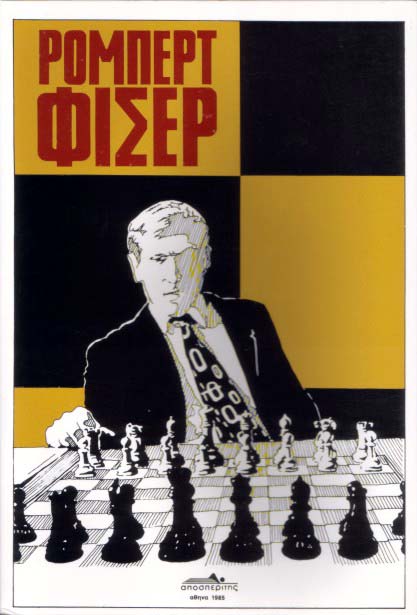

These drawings have appeared in chess books, but it will be astounding if any reader can identify the two (very well-known) masters.
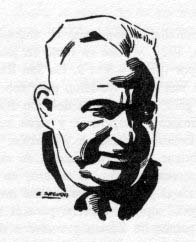

Pages 412-413 of A Chess Omnibus had some quotations from Richard Penn. Here now are a few more, from his book Maxims and Hints on Angling, Chess, Shooting and Other Matters (London, 1842):
‘If the by-standers talk, it is still more annoying; they always claim the merit of having foreseen every good move which is made, and they sometimes express great surprise at your not making a particular move which, if you had made it, would probably have led to your speedily losing the game – before which time they would have walked away to another table.’ (Pages 60-61)
‘Almost every moderate player thinks himself fully qualified to criticize the move by which a game has been lost. Although, if he had himself been in the loser’s place, he would, very probably, have been checkmated 20 moves sooner than the opportunity occurred for committing the particular mistake which he thinks he should have avoided.’ (Page 61)
‘... It is well known that men of the highest attainments have studied chess without great success; and that the most celebrated players have not always been men of distinguished talents.’ (Page 75)
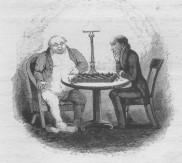
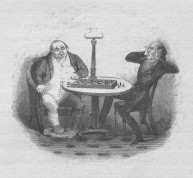
The above two wood-cuts appeared in Penn’s book, on pages 57 and 76 respectively.
What, we wonder, is the shortest miniature which has ended in mate after an exchange of queens? Our proposal is 1 e4 e5 2 Nf3 d5 3 exd5 Qxd5 4 Nc3 Qa5 5 Qe2 Nc6 6 d3 Bg4 7 Bd2 Nd4 8 Qxe5+ Qxe5 9 Nxe5 Nc2 mate. This game was given as won by Oberhauser (with no other details) on page 92 of 666 Kurzpartien by K. Richter (Berlin-Frohnau, 1966), but the heading was Abrikossomsky v Parkov, Moscow, 1938 on page 9 of Ajedrez brillante by R. Crusi Moré (Barcelona, 2001).
From Pierre Bourget (Beauport, Canada):
‘I am searching for the scores of the games played by Spassky, Portisch and Mariotti against chess computers in 1973 and 1975. These encounters are reported on page 185 of Le Grand Livre de l’Histoire des Echecs by A. Capece, (Paris, 2001).’
Capece stated (see also pages 181-182 of the Italian edition, Gli scacchi nella storia e nell’arte) that in June 1973 Spassky was challenged to a game against a computer program devised by a mathematician named Kurt Fischer which operated on an IBM 370; the computer, playing Black, was mated on move 18 after making a theoretical error on its fifth move. As regards Portisch and Mariotti, Capece’s book reported that at a congress in Pisa in October 1975 the Snark program of Michael Saliba (Malta) lost its games against the masters in 30 and 41 moves respectively, and was defeated even faster in the return games.
All we have found so far is the first half of a game between Snark and Portisch (who was Black): 1 c4 c5 2 e4 Nc6 3 Nc3 g6 4 d3 Bg7 5 Nf3 d6 6 Bg5 Bg4 7 Nd5 h6 8 Bc1 e6 9 Nc3 Bxf3 10 Qxf3 Nd4 11 Qf4 h5 12 h4 Ne7 13 Be2 Be5 14 g3 Bxf4 ‘and Black won after another 16 moves’. This is taken from page 42 of I giocatori artificiali by P. Ciancarini (Milan, 1992), which gave the date of the encounter as (October) 1977, not 1975.
The longest letter we ever received from Harry Golombek was in the summer of 1985, and before reproducing it we summarize the context.
Regarding the anti-Semitic articles attributed to Alekhine, C.N. 990 included some comments to us from Anthony Saidy about two books by A. Kotov and M. Yudovich, The Soviet School of Chess (1958) and The Soviet Chess School (1983):
‘Whereas in 1958 no mention was made of the sticky subject of Alekhine’s petty collaboration with the Nazis in the form of those anti-Semitic essays which I believe were written so ludicrously as to telegraph their insincerity, now we learn that he was “unjustly accused of collaboration”. I believe this exculpation to be the most transparent rewriting of history for the hackneyed Soviet ideological purposes. When I pointed out to Kotov at Nice in 1974 the fact that a leading British figure had, after Alekhine’s death, found a version of the essays in his handwriting (where are they now?), thus proving their authenticity, if not their plausibility, he brushed it off as “British propaganda”.’
The vague term ‘leading British figure’ was used because, at that time, it was uncertain whether it was B.H. Wood (the name originally given to us by Dr Saidy), Golombek or someone else. We decided to raise the matter with H.G. As will be seen below, he not only replied regarding Alekhine but also commented briefly on another item in the same issue of our magazine (C.N. 1007), in which Hugh Myers had presented a three-page analysis of the termination of the first Karpov v Kasparov match and had come to conclusions sharply at variance with the prevailing view at the time.
‘From Harry Golombek
Albury
35 Albion Crescent
Chalfont St Giles
Bucks HP8 4ET.7 July 1985
Dear Mr Winter,
Many thanks for your kind note and for sending me issue 22 of C.N. However I must add that Mr Myers’ intervention in the Karpov-Kasparov dispute seems a little unhappy since he merely adds a little confusion to the whole unhappy incident about which he seems to have little first-hand knowledge.
The statement in The Times that I am fully on the mend is a little premature but it’s a little better than the previous bald statement that I was ill in hospital.
As a matter of fact the position is that my health is improving and that I must be thankful to my ancestors for bequeathing me a very strong heart capable of standing quite a lot of strain.
In addition the fact that I have never smoked and have drunk very little alcohol seems to have stood me in good stead as regards my major organs ...
[Here we omit about 300 words of personal/medical details.]
You will see by all this that I am a walking compendium of illnesses; but I’m determined to survive as I have at least five more books to finish writing and a great deal of Mozartian chamber music to which I want to listen.
Meanwhile a little clarification about the discovery of the Alekhine articles.
When Alekhine’s widow died Brian Reilly was in Paris and he was afforded the opportunity of examining her effects. When he returned from Paris he said to me sadly, “It’s true about the Alekhine anti-Semitic articles. I’ve seen them in Alekhine’s own handwriting”.
However, I should add that Reilly, who is writing a definitive biography of Alekhine and for whom Alekhine seems to have become a sort of chevalier sans peur et sans reproche, said to me a few months ago, “Where did you get the information in your article in your encyclopedia about Alekhine having written the anti-Semitic articles?”
Upon my telling him that I had got the information from him on his return from Paris, he denied that any such conversation had taken place. So you have to take your choice; either my memory is right (and I can still see in my mind’s eye Brian’s melancholy face as he told me this) or Brian’s memory is right and this never took place. I must add that most people find my memory is all right; nor do I experience any difficulty in remembering the appropriate facts for writing an article about something about 20 years ago.
However, you had better stick to a leading chess figure, which phrase can hardly be confused with such a character as Myers or B.H. Wood.
Meanwhile I intend to test my stamina and my memory and my chess skill by playing in the British veterans championship tournament at Edinburgh next August.
If I ever fully recover my health I intend to pay another visit to Geneva since I’d like to have another look at Mme de Staël’s beautiful house there and in that case I’ll pay you a visit in 9 rue de la Maladière; such a place should seem quite fitting for one who is a walking compendium of illnesses as I am and as I hope you are not.
Yours unhealthily but sincerely,
(signed) Harry Golombek.’
One point arising from this letter is Golombek’s reference to having ‘at least five more books to finish writing’. We are not aware of his having published any (new) books after 1985.
Following on from C.N. 3605 we now quote from page 5 of Alekhine Nazi Articles by K. Whyld (Olomouc, 2002):
‘In 1956 Brian Reilly (1901-1991) told me that he had seen the MS of the articles in Mrs Alekhine’s property. This was quoted by Hooper and me in The Oxford Companion to Chess (1984), whereupon Reilly said that this was not true. It transpired that he had seen a text, in Alekhine’s handwriting, which was said to be the MS, but Reilly, who could not read German, did not like being quoted in evidence.’
For further particulars, below is part of a letter Mr Whyld wrote us on 4 May 1989:
‘Reilly talked to me a couple of years or so ago about the manuscript, but he does not want what he says to appear in print, so I ask you to respect his wishes during his lifetime. He regrets telling Golombek and myself about the manuscript (on separate occasions). He says that the notebooks were shown to him by Halberstadt, who told him what was in them, but that he, Reilly, could not read German and does not want to be cited as proof of their contents. What’s more, he specifically asked that I should not try to elaborate in print because “it would only make matters worse”. I felt that there was an additional element in Reilly’s attitude. He lived in France during the War and knew how human it was to make conciliatory gestures towards the Nazis in order to get by, and also how intolerant some were, who, for example, had lived in USA throughout the War, towards such frailty.’
From our reply to Mr Whyld, dated 26 May 1989:
‘B.R.’s reaction is understandable yet still questionable, in my view. Since his testimony was the basis of the statements in Golombek’s encyclopaedia and The Companion, he might have been expected to clarify things in print by now. I sent him a copy of [an article about Alekhine and the anti-Semitism charges, which we had contributed to the 2/1989 New in Chess, pages 68-70] and received a card of acknowledgement (which indicated that all the real writing of his Alekhine book has yet to be done). It is evident that he does not wish to discuss anything.’For the record, Brian Reilly’s postcard to us, dated 6 May 1989, courteously thanked us for the New in Chess article and merely added:
‘Je continue à collectionner des renseignements sur Alekhine, et – Deo volens! – j’espère pouvoir m’atteler à la rédaction de sa biographie l’an prochain.’
Brian Reilly was one of the least obtrusive editors of the BCM and possibly the best of all.
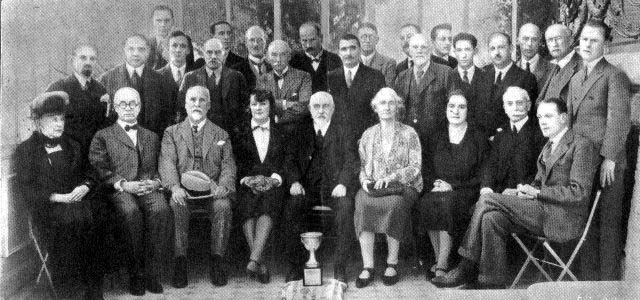
This photograph, taken at the Hyères, 1927 tournament, appeared in the March 1927 issue of L’Echiquier. The magazine gave the names as follows:
Seated (left to right): ‘Mrs Conybeare, Dr Telling, M. A.J. Maas, Mme de Fridman, I. Gunsberg, Mrs Holloway, Miss Maas, Cte J. de Villeneuve Esclapon, N. de Fridman.’
Standing: ‘MM. A. Baratz, L. Szwarzman, E. Glogg, B. Reilly, Stuart-Prince, H. Grob, S.J. Holloway, X, Dr E.H. Smith, R. de Pampelonne, Dr Rutherford, M. Paull, J. Keeble, Daschmann, W. Orbach, J. de Sandal-Roy, R.H.V. Scott, G.K. Nuttall, E. Beltikhine.’
From John Donaldson (Berkeley, CA, USA):
‘Simon Constam of Hamilton, Canada raises a very interesting question. Page 12 of The Grünfeld Defence by William Hartston (London, 1971) gives the sequence 1 d4 Nf6 2 c4 g6 3 Nc3 d5 4 cxd5 Nxd5 5 e4 Nxc3 6 bxc3 c5 7 Nf3 Bg7 8 Be2 O-O 9 O-O b6 10 Be3 Bb7 11 e5 cxd4 12 cxd4 Na6 13 Qa4 Nc7, with the better game for Black, Rubinstein-Alekhine, 1924. I have seen no source on either Rubinstein or Alekhine that gives this game and could find no encounter in MegaDatabase 2005 that reached the position after 13...Nc7. Any help on resolving this mystery would be gratefully appreciated.’
Why and when this faulty game reference started appearing in chess literature is unknown to us, but we mentioned it in C.N. 917 after noting the citation ‘Rubinstein-Alekhine, match 1924’ on page 99 of that gaffes-à-gogo book Batsford Chess Openings (London, 1982).
Further to the quoted statement from Chess Pie,1922 that Fink had scored two draws against Capablanca in simultaneous exhibitions, Neil Brennen (Malvern, PA, USA) cites from the Pittsburgh Gazette-Times of 11 June 1916 the following remark by Fink: ‘masters I have met include Capablanca, Marshall and Kostić, a draw from each in simultaneous play’. This means, assuming that the Chess Pie reference to two games was correct, that a second draw between Capablanca and Fink occurred between mid-1916 and 1922, but when?
From Tony Gillam (Nottingham, England):
‘In 1992 I agreed to publish a new, revised edition of volume 1 of Jeremy Gaige’s Chess Tournament Crosstables. He sent me a box with about 500 tables. Each one has the date on which he made his last revision/proof-read – August and September 1992.
Both Ken Whyld and I sent him supplementary information, but in view of health problems and computer failures he was unable to typeset the planned new edition. The appearance of the recent book Chess Results, 1747-1900 has made me regret not simply publishing what he sent me in 1992. How many crosstables Jeremy Gaige has in total I do not know, but some years ago the figure was already over 8,000.
His diligence on the Personalia projects has been remarkable. The number of people that he “pursued” and the sheer quantity of detail he unearthed are stunning. The chess world is very lucky to have him.’
It may be recalled that the well-known Alekhine v Capablanca photograph purportedly taken at Buenos Aires, 1927 is demonstrably a fake, although the hope we expressed in C.N. 3519 that it would therefore be removed from Kasparov’s ‘chesschamps’ website has not yet been fulfilled.
Now Birger Flindtholt (Randers, Denmark) writes:
‘I found an interesting drawing in a recently acquired book, Lehrbuch des Schachspiels by Emanuel Lasker (4. Auflage, 1927). Bound together with the book was a German-language newspaper cutting reporting on the third round of the Moscow, 1925 tournament and dated 13 November. The report included a sketch of Capablanca and Lasker seated at a chess board. The position on the board makes no sense.’
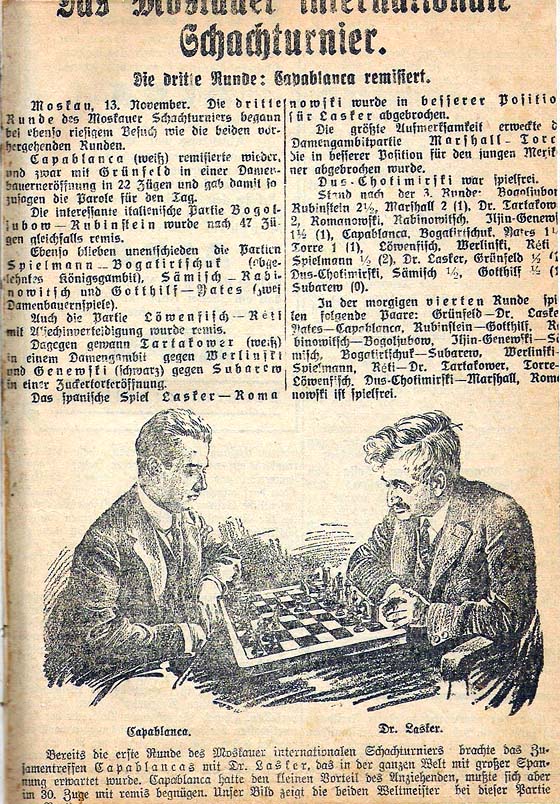
Capablanca and Lasker met in the first round of the Moscow tournament, on 10 November 1925, the opening being a Queen’s Gambit Declined. The Capablanca sketch is evidently based on the photograph of him given in our earlier items and published on, for instance, page 14 of the ‘1. Extra-Ausgabe’ of Kagans Neueste Schachnachrichten in late 1925 or early 1926, whereas the drawing of Lasker corresponds to a photograph given two pages earlier in the same issue:
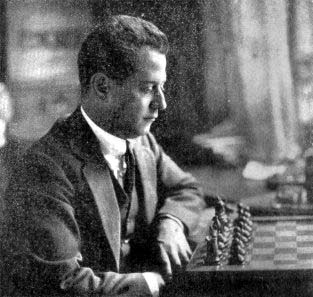
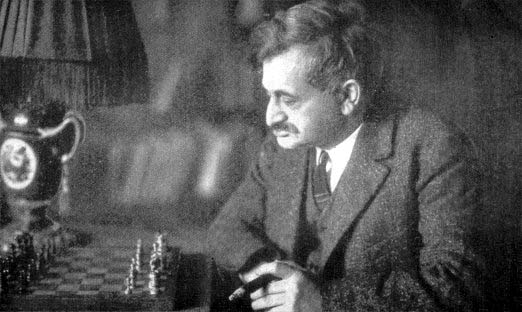
The following composition (White to draw) won second prize for A. Prokopchuk in a Ukrainian tourney in 1971 according to Study Database 2000:

1 Ke3 Kc4 2 Kd2 Kb4 3 Kc1 Kc3 4 Kb1 Kd2

5 c4 Kc3 6 Kc1 Kxc4 7 Kc2 Kd4 8 Kd2 c4 9 Kc2 c3 10 Kd1 Kd5 (evidently a mistranscription of 10...Kd3) 11 Kc1 c2 12 a3 Drawn.
At move five White would seem to be in extremis, but the
same drawing line had already occurred over the board, twice. The
first such game we came across was between Beltrán and Pomar in
the Spanish championship, Saragossa, October-November 1957, the
ending of which was analysed on pages 103-104 of a little-known
book by Arturo Pomar, Las pequeñas ventajas en el final
(Madrid, 1958). We quote below his notes in full, and it will be
seen that the play he recorded corresponds exactly to the above
study. (The analysis in the book had three impossible moves or
typos, and we have italicized them.)
‘As will be realized, Black should apparently win easily, by dint of having his king in a magnificent situation and well advanced pawns. However, after painstaking analysis White found the only precise move to draw, based on the plan of sacrificing a pawn to obtain the opposition.At the moment, Black is threatening to win with the following logical continuation: 1 Kg2 f4 2 Kg1 (if 2 Kh3 Kxf2 3 Kxh4 Kg2 4 Kg4 f3 5 h4 f2 6 h5 f1(Q), promoting the pawn with the advantage of several tempi) 2...f3 (or 2...h3 3 Kh1 Kf1 4 f3 Ke2 5 Kg1 Ke3 6 Kf1 Kxf3 7 Kg1 Ke2, winning) 3 h3 Ke1 4 Kh2 Kxf2, winning.
1 f4
With this move White ensures a draw.
1...Kf3
If 1...h3 2 Kh1 Kf3 3 Kg1 Kxf4 4 Kf2 Ke4 5 Ke2 (not 5 Kg3 Ke3 6 Kxh3 f4 7 Kg4 [7 Kg2 loses a tempo, owing to 7...Ke2] 7...f3, promoting the pawn several tempi ahead) 5...f4 6 Kf2 f3 7 Kf1 Ke3 8 Ke1 f2+ 9 Kf1 Kf3 stalemate.
2 Kf1 Kxf4
If 2...Kg4 3 Kg2 h3+ 4 Kf1 Kxf4 5 Kf2, transposing into the main line in the previous note.
3 Kf2 Ke4
If 3...h3 4 Ke2! Ke4 5 Kf2 f4 6 Ke2, etc.
4 Ke2 f4
If 4...h3 5 Kf2 Kd4 6 Kf3 Kd3 7 Kf2 (it is not possible to play 7 Kf4 Ke2 8 Kxf5 [if 8 Kg3 Ke3 9 Kxh3 f4, winning] 8...Kf3 9 Ke5 Kg2 10 Ke4 Kxh2 11 Kf3 Kg1, promoting) 7...Kd2 8 h3 Kd3 9 Kf1 Kd2 10 Kf2 and draws.
5 Kf2 f3 6 Ke1
6 Kf1? Ke3 7 Kf1 f2+ 8 Kf1 Kf3! 9 h3 Ke3 or Kg3, winning.
6...Ke3 7 Kf1
If 7 h3 Ke4! 8 Ke1 (if 8 Kf2 Kf4 9 Kf1 Kg3, winning) 8...Ke3 9 Kf1 f2 10 Kg2 Ke2, winning.
7...f2
If 7...Kf4 8 Kf2 Kg4 9 Kf1 Kh3 10 Kf2 Kxh2 11 Kxf3 h3 (if 11...Kg1 12 Kg4, winning the pawn) 12 Kf2 Kh113 Kf1, restricting the king to the h-file.
8 h3 Drawn.
The continuation would be 8...Ke4 9 Kxf2 Kf4 10 Kg2 Ke3 11 Kg1 Kf3 12 Kf1 Kg3 13 Kg1 Kxh3 14 Kh1 Kg3 15 Kg1 h3 16 Kh1, and drawn because it is a rook’s pawn.’
The comments in square brackets above are also by Pomar. He wrote that the pawn ending arose after ‘a very hard-fought game’, and we note that the score given in the Mega Database 2005 has a different conclusion: 1 d4 d5 2 Nf3 Nf6 3 c4 c6 4 Nc3 e6 5 e3 Nbd7 6 Bd3 dxc4 7 Bxc4 b5 8 Bd3 a6 9 e4 c5 10 e5 cxd4 11 Nxb5 axb5 12 exf6 Qb6 13 fxg7 Bxg7 14 Qe2 O-O 15 O-O Bb7 16 Re1 e5 17 Nh4 e4 18 Nf5 Nf6 19 Bxb5 Qc5 20 Nxg7 d3 21 Bxd3 exd3 22 Qxd3 Kxg7 23 Bf4 Rfe8 24 Qg3+ Kh8 25 Be5 Qb6 26 Qg5 Rxe5 27 Qxe5 Rg8 28 g3 Qc6 29 Re4 Re8 30 Qxf6+ Qxf6 31 Rxe8+ Kg7 32 Rb8 Qxb2 33 Rf1 Qb6 34 Rd1 h5 35 Rxb7 Qxb7 36 Rd4 Qb1+ 37 Kg2 Qxa2 38 Rf4 Kg6 39 Rh4 Kg5 40 Rf4 f5 41 Rh4 Qd2 42 Kg1 Kf6 43 Kg2 Qd5+ 44 Kg1 Ke5 45 Rf4 Qb7 46 Rh4 Qc6 47 Rf4 Qc1+ 48 Kg2 Qxf4 49 gxf4+ Kxf4 50 Kg1 Kf3 51 Kf1 h4 52 Kg1 Ke2 (Reaching the position in the diagram above.) 53 f4 Kf3 54 Kf1 Kxf4 55 Kf2 Ke4 56 Ke2 f4 57 Kf2 f3 58 Ke1 Kf4 59 Kf2 Ke4 Drawn.
The database has another game in which the same critical position arose: Berndt Söderborg (Sweden) v Dolfi Drimer (Romania) in the Fourth World Students’ Team Championship in Reykjavik, July 1957: 1 e4 c5 2 Nf3 d6 3 d4 cxd4 4 Nxd4 Nf6 5 Nc3 a6 6 Bg5 e6 7 f4 h6 8 Bh4 Qb6 9 Qd2 Qxb2 10 Rb1 Qa3 11 e5 dxe5 12 fxe5 Nfd7 13 Be2 Be7 14 Bxe7 Qxe7 15 Qf4 O-O 16 Ne4 Nc6 17 Nxc6 bxc6 18 O-O Rb8 19 Rxb8 Nxb8 20 Nf6+ Kh8 21 Bd3 Nd7 22 Kh1 Qc5 23 Nxd7 Bxd7 24 Qe4 g6 25 Qf4 Kg8 26 Rf3 a5 27 Qf6 Be8 28 h4 h5 29 Kh2 Qb4 30 Rg3 Qd2 31 Be4 a4 32 Qf3 c5 33 Qxh5 Qf4 34 Qg4 Qxe5 35 h5 f5 36 Qg5 Qxe4 37 hxg6 f4 38 Rg4 Bxg6 39 Qxg6+ Qxg6 40 Rxg6+ Kf7 41 Rg4 e5 42 g3 Rg8 43 Rxg8 Kxg8 44 gxf4 exf4 45 Kg2 Kf7 46 Kf3 Ke6 47 Ke4 f3 48 Kxf3 Kd5 49 Ke3 Kc4 50 Kd2 Kb4 51 Kc1 Kc3 52 Kb1 Kd2 (This position is identical to the one reached after move four in the Prokopchuk study.) 53 c4 Kc3 54 Kc1 Kxc4 55 Kc2 Kd4 56 Kd2 c4 57 Kc2 Kc5 58 Kc3 Kb5 59 Kc2 Kb4 60 Kb2 Kc5 61 Kc3 Kd5 62 Kc2 Kd6 63 Kc3 Kd5 64 Kc2 Kd4 65 Kd2 c3+ 66 Kc2 Kc4 67 Kd1 Kd5 68 Kc2 Kd4 69 Kd1 Kc5 70 Kc1 Kb4 71 Kc2 Kc4 72 Kd1 Kd3 73 Kc1 Ke4 74 Kc2 Kd4 75 Kd1 Kd3 76 Kc1 c2 77 a3 Kc3 Drawn.
When the conclusion of this game was given on page 140 of Pawn Endings by Y. Averbakh and I. Maizelis (Oxford, 1987) the colours were reversed (i.e. Drimer was given as White). Two coincidences in the games are striking: both were played in 1957 and both had the surprising advance of the bishop’s pawn at move 53.
The over-the-board intricacies of a simple-looking endgame are matched by the historical complications; in particular, what can be found out about Prokopchuk and his study and did Pomar’s book give an incorrect conclusion to his game?
C.N. 3572 gave from page 81 of The Gambit, March 1928 a press cutting which stated that a 17-year-old girl and expert typist named Birdie Reeve ‘has just played simultaneously 10 of the leading chess players of the West and claims championship of her sex’.
Jerry Spinrad (Nashville, TN, USA) provides us with a large number of newspaper quotations about her typing exploits (which made her a vaudeville star) and family background, although he has found only one reference to chess. This was a report on page 12 of the Washington Post, 11 November 1928 entitled ‘Masters at Chess Draw with London’, which ended as follows:
‘Miss Birdie Reeves [sic], one of the best women chess players in America, was also on the scene during the major part of the performance and furnished excellent entertainment for the gathering of fans.’
This event, a Washington v London cable match on 10 November featuring such players as Mlotkowski, Whitaker, Yates and Michell, was the subject of reports on page 182 of the December 1928 American Chess Bulletin and pages 441-443 of the December 1928 BCM, but they made no mention of Birdie Reeve.
The other quotations provided by Mr Spinrad are, despite their lack of chess content, of much interest, and we therefore present them in full, as a supplement to the present item.
An earlier game than the one mentioned by a correspondent in C.N. 3581 has been provided by Dominique Thimognier (St Cyr sur Loire, France) from a database: 1 d4 Nf6 2 Nf3 e6 3 c4 d5 4 Nc3 Be7 5 Bg5 O-O 6 e3 h6 7 Bh4 Ne4 8 Bxe7 Qxe7 9 cxd5 Nxc3 10 bxc3 exd5 11 Qb3 Rd8 12 c4 Be6 13 c5 b6 14 Rc1 Nd7 15 cxb6 axb6 16 Bb5 c5 17 Bxd7 Qxd7 18 dxc5 bxc5 19 O-O Qd6 20 Qc2 Rdc8 21 a4 Ra5 22 Rfd1 Qa6 23 Ra1 Rb8 24 Rdb1 Ra8 25 h3 Qc8 26 Rb6 g6 27 Qb2 Kh7 28 Qe5 Qh8 29 Rc6 Qxe5 30 Nxe5 c4 31 Rc7 Kg7 32 Rb1 Rxa4 33 Rbb7 Rf8 34 Re7 Ra1+ 35 Kh2 Kf6 36 f4 Re1 37 Ng4+ Bxg4 38 hxg4 c3 39 Rec7 Rxe3 40 Rb6+ Kg7 41 Rd6 Rd3 42 White resigns (P. Aguirre v F. Benkö, Championship of Argentina, Buenos Aires, 1945).
Although we have not yet found this game in a contemporary source, we note a two-page article entitled ‘Una Novedad de Ovsey Cotlar en la Defensa Lasker del Gambito de Dama’ by Karel Skalička on pages 144-145 of the Argentinian magazine Enroque!!, December 1945. It describes Ovsey Cotlar as a Russian engineer from Kiev who used to play with Bogoljubow in 1911-12, and Skalička also states that he sent analysis to his compatriot Walter Korn for possible inclusion in the seventh edition of Modern Chess Openings. As noted in C.N. 3581, Korn did indeed mention the Cotlar line there.
Loyd gave the following illustration to show that the diagram could be divided into 18 pieces:

This poser has been taken from pages 51 and 145 of More Mathematical Puzzles of Sam Loyd by M. Gardner (New York, 1960). Gardner added the following observation:
‘There are many different ways that the board can be divided into 18 different pieces. As an interesting exercise, the reader may try to work out a proof that 18 is indeed the maximum number.’
As has been mentioned many times (see also page 5 of the 2/1994 New in Chess and page 15 of Schaakromanticus Miguel Najdorf by S.H. Postma), Najdorf did not play his ‘Polish Immortal’ game in 1935, as was once believed. The score had already been published in Dzien Polski in August 1930 and in Právo lidu on 1 November 1930, the latter’s source being Kurjer Warszawski.
Of course, this has become so well known that no competent chess writer would put ‘1935’ today.
From Mark N. Taylor, who is Assistant Professor of English at Berry College, Mt Berry, GA, USA:
‘“Chess and Chessic Motifs in English Prose Narrative Since 1700: An Annotated Bibliography” aims to be a comprehensive listing of narratives which include chess in substantial or significant ways. Each entry will be annotated, summarizing the chess content. The project currently lists over 1,000 titles. The finished list will probably number between 1,500 and 2,000 titles. I welcome any assistance, particularly in identifying the less obvious books and short narratives, especially for the period 1945 to about 1985, including short stories published in chess periodicals. Anyone wishing to contribute relevant information should contact Mark N. Taylor at mtaylor@berry.edu, or at the Department of English, Box 350, Berry College, Mt Berry, GA 30149-0350, USA.’
Our correspondent has provided the following sample entry from his project:
‘Brunner, John. The Squares of the City. New York: Ballantine, 1965. 319 pp. Pbk. Intro. by Edward Lasker. (GENRE: Fantasy thriller novel by a noted science-fiction author. SUMMARY OF CHESS CONTENT: The story is not about chess but about two South American political antagonists and their followers. The main plot, however, is precisely structured according to the moves of the 16th Steinitz-Chigorin world championship match game, Havana, 1892, explained in the author’s end note. Brunner returns to this theme in his 1980 novel, Players at the Game of People, but without explicit chess references. MOTIF: life is like a chess game.)’
Hassan Roger Sadeghi (Lausanne, Switzerland) writes: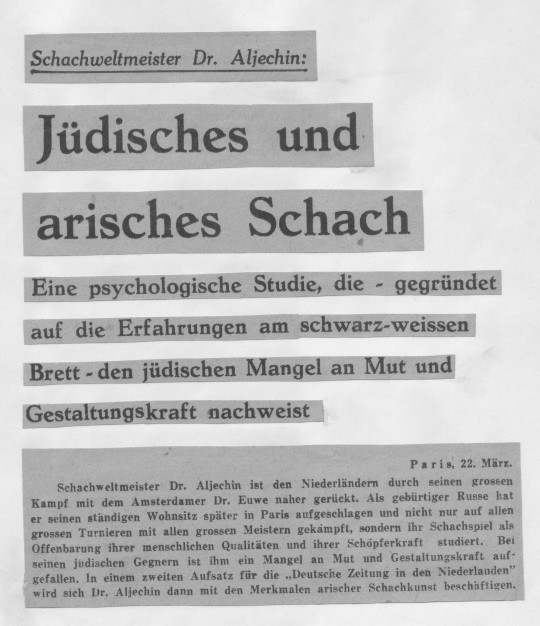
‘We seem to have only hearsay evidence, at best, that these manuscripts have been proven to exist in Alekhine’s own hand. The question now is: whatever happened to these documents? If Halberstadt had them once, where may they be now?’
The whereabouts of the handwritten version of the articles, which were published in the Nazi press in 1941, are unknown. As far as we are aware, and we have discovered nothing new of substance since writing the account given on pages 309-313 of Kings, Commoners and Knaves, there are (leaving aside Alekhine’s widow, who died in 1956) three people, all deceased, who are on record as having seen the articles in Alekhine’s handwriting: Vitaly Halberstadt, Brian Reilly (who was shown them in Paris in 1956 by Halberstadt) and Jacques Le Monnier (shown them in 1958 by an unnamed person, who may or may not have been Halberstadt). Whether the articles were ever in the keeping of Halberstadt (who died in Paris in 1967) we do not know, but it may be wondered whether Golombek was quite correct in writing to us in 1985 (see C.N. 3605), ‘When Alekhine’s widow died Brian Reilly was in Paris and he was afforded the opportunity of examining her effects’, given that on page 301 of the May 1986 Europe Echecs Jacques Le Monnier stated that the ‘Nazi articles’ notebook was one of about 20 Alekhine volumes on various matters which Grace Alekhine had given to an unidentified person some time before her death:
‘Avant de mourir, Grace Alekhine avait confié différents carnets de son mari à un de ses amis. Il y en avait une vingtaine, de tous les formats, de toutes les époques. Ils contenaient des détails touchants (une note de blanchisseur, la location d’une redingote) et la plupart des manuscrits dont, par exemple, en anglais, les parties de Buenos Aires 1939 publiées en Espagne dans Gran Ajedrez.’
This gives rise to a further complication, because when substantial material (i.e. annotations) from the notebooks was published in Gran Ajedrez (Madrid, 1947), the editor of that book, Ricardo Aguilera (1912-1972), wrote in an introductory explanation that he had been presented with the notebooks by Alekhine:
‘El Dr Alekhine era un hombre de agudísimo espíritu crítico y, al mismo tiempo, se complacía en anotar cuidadosamente sus observaciones y sus estudios sobre las partidas, propias o ajenas, que más llamaban su atención.
Estos estudios se hallan recogidos en los cuadernos de que nos hizo obsequio, y de los cuales, para curiosidad del lector, reproducimos la fotografía de algunas de sus páginas, escritas de puño y letra del gran campeón del mundo.’
That first edition of Gran Ajedrez reproduced three pages from the notebooks, including the following (concerning Enevoldsen v Alekhine, Buenos Aires, 1939):
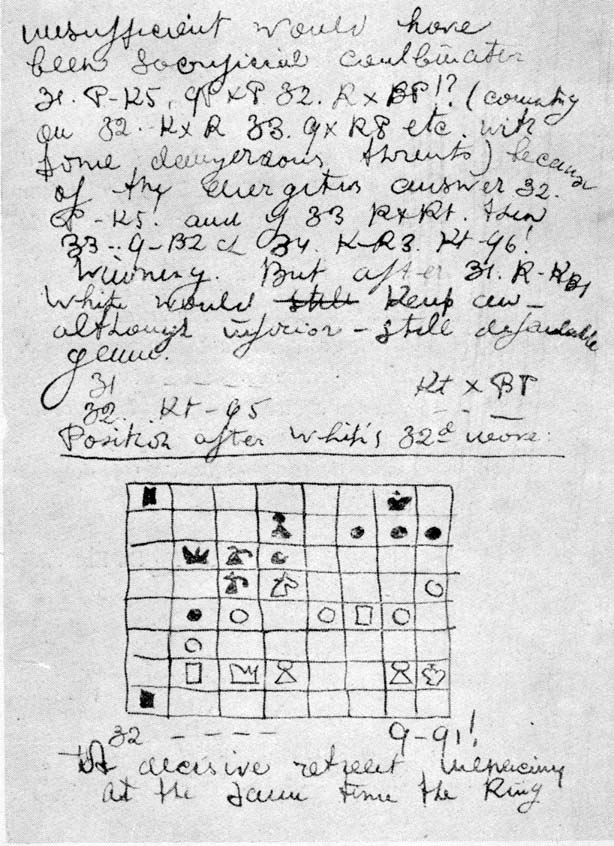
On the last two (unnumbered) pages of a further introduction in Gran Ajedrez Ricardo Aguilera wrote that the notebooks were handwritten in German, French and English and dated from various periods, although the oldest was from 1941. (‘Los cuadernos de Alekhine están escritos de su puño y letra en alemán, francés e inglés ... Los cuadernos están escritos en diversas épocas, si bien el más antiguo es del año 1941.’) Aguilera reported that Alekhine gave him the volumes out of gratitude to the magazine Ajedrez Español, with the world champion saying that they were rather like children to him and had accompanied him on his travels: ‘Estos cuadernos son algo así como hijos míos. Los quiero con cariño de padre. Conmigo fueron en mis viajes ...’
Nothwithstanding the reference by Aguilera to 1941, he gave no
indication of whether the Nazi articles were in the notebooks he
had acquired, or how many notebooks he had. He merely spoke of ‘varios
cuadernos’ (i.e. several notebooks). On the other hand,
the fact that both Aguilera and Le Monnier referred to writings
by Alekhine on the Buenos Aires, 1939 Olympiad suggests that at
least some of the notebook material located in Spain in the
1940s found its way, by the 1950s, to Paris.
As regards, finally, legal restrictions on the handwritten material becoming public, on page 6 of the 4/1989 New in Chess Le Monnier wrote in response to our article in that magazine:
‘Alekhine’s notebooks are private documents and French law is categorical in this respect. They will enter in the public domain 60 years after the author’s death, i.e. in 2006. After this date historians and researchers may consult them, provided that Alekhine’s heirs and the owners of the notebooks agree.’
The rights and wrongs of what Le Monnier wrote at that time are now academic, because French copyright law changed in the mid-1990s, and Article L123.1 of the current Code de la propriété intellectuelle provides for a term of 70, not 60, years post mortem auctoris. (Similar amendments of national laws were made throughout the European Union, following on from the ‘Council Directive 93/98/EEC of 29 October 1993 harmonizing the term of protection of copyright and certain related rights’.) In the absence of special circumstances the Alekhine ‘Nazi articles’ will enter into the public domain on 1 January 2017.
Jerry Slocum (Beverly Hills, CA, USA), who is working on a book about the 14-15 Puzzle, asks about the origins of the Sam Loyd sketch given in C.N. 3458:

We took it from page 193 of the March 1892 issue of the Chess Monthly, which did not indicate whether or not it was drawn by Loyd himself. However, it is evidently based on a photograph of Loyd which was later reproduced in, for instance, a montage on page 75 of the American Chess Magazine, July 1897:
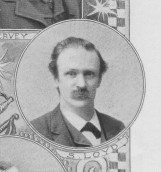
C.N. 3603 proposed a nine-move win for Black as ‘the shortest miniature which has ended in mate after an exchange of queens’, and we are now grateful to Birger Flindtholt (Randers, Denmark) for two shorter ones:
‘The first is from page 147 of the Chess Amateur, February 1908 and has the caption ‘Won by J.G. Harrison (Manchester C.C.)’: 1 e4 e5 2 d4 d5 3 dxe5 dxe4 4 Qxd8+ Kxd8 5 Nc3 Bb4 6 Bd2 Bf5 7 O-O-O Bxc3 8 Bg5+ Ke8 9 Rd8 mate.
The second game is from page 10 of Chernev’s 1000 Best Short Games of Chess, and is stated to have been played between the problemist Charosh and L. Jaffe in New York in 1936: 1 d4 c5 2 d5 Na6 3 Nf3 d6 4 e4 Bg4 5 Ne5 Qa5+ 6 Bd2 dxe5 7 Bxa5 Bxd1 8 Bb5 mate.’
As ever, more information is invited on these games.
The strongest tournament in which Jacob Bernstein participated was Carlsbad, 1923, where he finished 13th out of 18, winning games against Bogoljubow, Yates, Rubinstein, Thomas and Chajes. A photograph of him with the last-named is reproduced here from the tournament book:
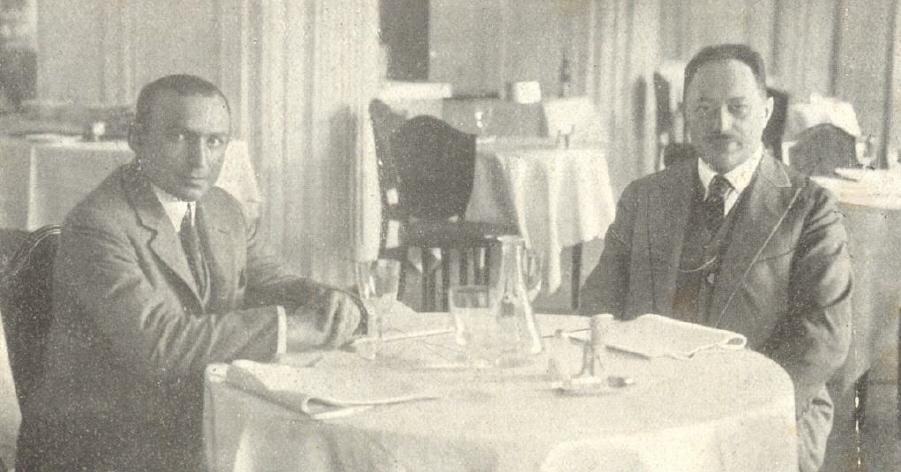
Jacob Bernstein and Oscar Chajes
But when did Bernstein die? At present, we have nothing firmer than what Sidney Bernstein told us in a letter dated 29 April 1987 (C.N. 3153): ‘Jacob Bernstein was Jewish and probably died in 1959’. Who can find out more?
Following on from C.N.s 3578 and 3592, readers are invited to reflect upon which chess figure wrote a book containing this text:
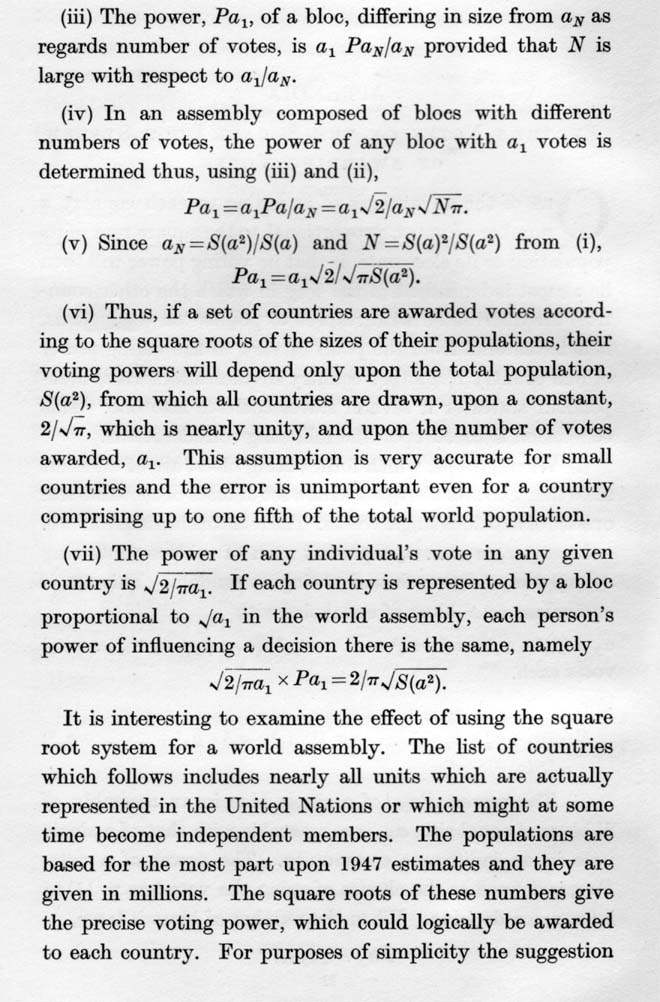
Wanted: information about the nineteenth-century player Nicolai Gedalia (1857-80). He won the Minor Tourney at New York, 1880 ahead of D.G. Baird, A. Ettlinger and J.W. Baird, and two of his games were published on pages 389-393 of The Fifth American Chess Congress by C.A. Gilberg (New York, 1881). On page viii Gilberg wrote:
‘It is a source of deep regret that this acknowledgement of gratitude cannot now reach one who labored most cheerfully and earnestly in the work – one whose youthful years, keen intelligence and eager enthusiasm gave promise of an enviable future, but whose earthly career was cut off by a sad and sudden catastrophe on the morning of the 13th of last November – the lamented Nicolai Gedalia, victor in the Minor Tournament, whose name will be found prefixed to many of the Notes.’
That no reader sent us a correct identification of either master is neither surprising nor blameworthy.
The first drawing was, supposedly, of Bogoljubow, taken from page 138 of Historia general del ajedrez by Julio Ganzo (Madrid, 1973):

The second one appeared twice (on pages 194 and 270) in Kajsa och den magiska schackboken by Jesper Hall (Stockholm, 2003) and was, preposterously, labelled ‘Adolf Anderssen’:

In an article on page 195 of the September 1971 Chess Digest Magazine William Winter (1898-1955) was given the Koltanowski treatment:
‘Winter was a heavy drinker and one of the best chess stories I know is the one of the committee that was formed in 1927 just before the International tournament was to take place in London. They raised one hundred pounds (about 350 dollars then) to support William Winter, so that he could win the event with great ease. In the first round William Winter came into the playing hall, breathing harshly and he beat the great Richard Reti. The next day, Winter weaved into the playing room, sat down at his board and beat the perplexed Aron Nimzowitch. The third day Winter staggered to his seat and beat my co-patriot, Edgar[d] Colle. It looked like it was going to be a big triumph for British Chess. But the expectations were short-lived. Winter had spent all the raised funds on booze in the first three days, and the so-called Winter Committee couldn’t raise another penny from its supporters. The first prize was only one hundred pounds! William Winter arrived sober for each round after the third and lost every game.’
Let us, firstly, compare the above with the complete record of the tournament given in M.A. Lachaga’s comprehensive book on the event, published in 1968. William Winter’s round-by-round performance was as follows:
1: lost to Fairhurst
2: beat Buerger
3: beat Thomas
4: drew with Marshall
5: lost to Bogoljubow
6: drew with Yates
7: lost to Tartakower
8: beat Nimzowitsch
9: drew with Colle
10: lost to Réti
11: beat Vidmar.
This placed him among the prize-winners, i.e. equal sixth with Réti. He did not defeat Réti or Colle; nor did he play in the first three rounds any of the masters named by Koltanowski. About the alleged ‘Committee’, we know nothing, but it may be wondered who would put together £100, or any other sum, so that W.W. could win ‘with great ease’ a tournament which included Bogoljubow, Marshall, Nimzowitsch, Réti, Tartakower and Vidmar. Moreover, £100 (the amount which, Koltanowski alleges, was spent on alcohol consumption within three days) was then roughly $500, not $350. In today’s money it would come to over $5,000. Finally, the first prize in the tournament was not £100 but £50 (BCM, August 1927, page 335).
Thus every verifiable ‘fact’ in Koltanowski’s yarn is false. Why? Was he guilty, once more, of ‘mere’ sloppiness and doltishness (page 341 of the September 1922 BCM was certainly inspired when it spelt his name ‘Klotanowski’) or was there also a darker side to his compulsive fabrications? William Winter was indeed known to drink heavily, but what sort of human being would, in ‘one of the best chess stories I know’, publicly ridicule a deceased master for alcoholism without making the remotest effort to be truthful?

William Winter
No reader has yet pointed out any pre-1951 instances of Reinfeld writing his quip ‘The pin is mightier than the sword’. We can, though, add that on page 159 of his book Great Moments in Chess (New York, 1963) he offered a simple variant: ‘... the pen is mightier than the pin’.
C.N. 2987 mentioned that a BBC television programme had attributed to Lenin the remark about chess being the gymnasium of the mind, which in fact dates back to Studies of Chess by P. Pratt (London, 1803). For the record we reproduce here the exact text in that book (page iii):
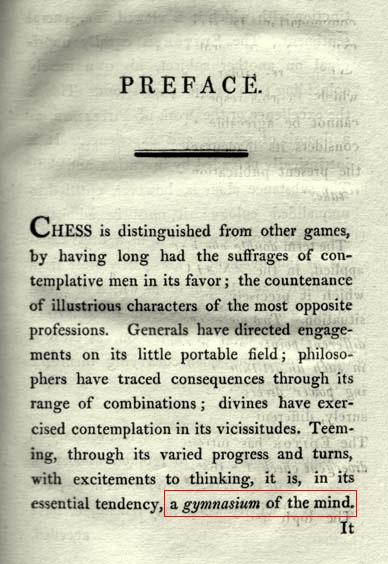
‘Chess is distinguished from other games, by having long had the suffrages of contemplative men in its favor; the countenance of illustrious characters of the most opposite professions. Generals have directed engagements on its little portable field; philosophers have traced consequences through its range of combinations; divines have exercised contemplation in its vicissitudes. Teeming, through its varied progress and turns, with excitements to thinking, it is, in its essential tendency, a gymnasium of the mind.’
On a number of webpages which pluck ‘chess quotes’ out of thin air and list them without any attributions or qualms the ‘gymnasium of the mind’ phrase is ascribed to Blaise Pascal, although we have yet to see an (alleged) original French version of the remark. That may be because according to the Robert dictionary the word gymnase is not recorded in the French language (with the meaning in question) until 1704, whereas Pascal died in 1662. Moreover, Georges Renaud wrote on page 28 of issue 17 of Les Cahiers de l’Echiquier Français (1928) that there was ‘aucune allusion directe aux échecs dans l’oeuvre de Pascal ’.
All kinds of chess remarks are put into the mouths or pens of everyone from Confucius to Kasparov, but there is one that is unlikely to be found listed on those awful ‘chess quotes’ webpages: an observation by Fischer during the fourth press conference in Sveti Stefan on 21 September 1992, as transcribed on page 117 of No Regrets by Y. Seirawan and G. Stefanović (Seattle, 1992):
‘– Are you more interested in women now than you were in 1972, when you said that chess was much more interesting?
Fischer: A lot of these quotes about me are not correct. Quotes of things I said.’
That documented remark of Fischer’s will, of course, be ignored, whereas unsubstantiated or invented quotes will continue to be propagated ad infinitum.
Given Karpov’s statement that a photograph of Fischer and him in Tokyo in the 1970s was distributed worldwide by the Agence France-Presse, it is strange that no reader has yet informed us where it may be seen.
C.N. 3594 reported Richard Forster’s suggestion, to make sense
of the game-score, that at move 33 Capablanca played Qe4, and
not Qf4 or Qf5. Now Neil Brennen (Malvern, PA, USA) informs us
that the same suggestion was made by Frisco Del Rosario on page
19 of the California Chess Journal, November/December
2002, as follows: ‘Maybe Capablanca played 33 Qe4, which ties
the black queen to the bishop, and watches the white squares on
the kingside.’
The letter below comes from our archives and is self-explanatory:

Chess Notes Archives:
| First column | << previous | Archives [6] | next >> | Current column |
Copyright 2005 Edward Winter. All rights reserved.